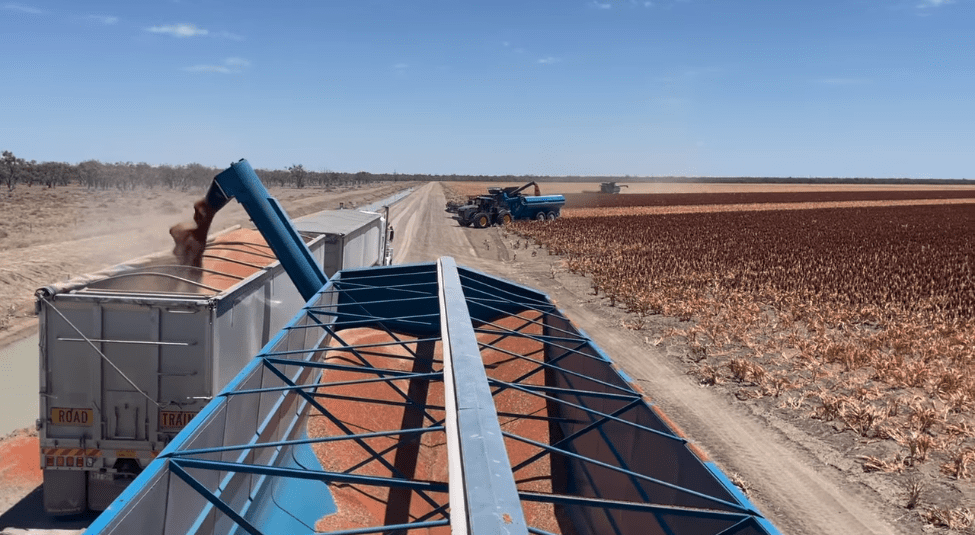
Harvesting and outloading sorghum at Brewarrina in the far north-west of NSW last week. Image: Troy Hamilton via CHS Broadbent
A TIGHTENING feed situation in South Australia has lifted bids for up-country barley by up to $15 per tonne in the past week as the hotspot in a flat to slightly firmer market for white grains.
In the north, growers continue to trickle wheat and barley into the feed market, and sell as much sorghum as they can without driving down prices.
| Feb 6 | Feb 13 | |
| Barley Downs | $315 | $318 |
| ASW Downs | $337 | $335 |
| Sorghum Downs | $320 | $322 |
| Barley Melbourne | $340 | $340 |
| ASW Melbourne | $365 | $360 |
Table 1: Indicative prices in Australian dollars per tonne.
Sorghum shipping nears
Limited on-farm storage for sorghum now being harvested at pace in north-west New South Wales and southern Queensland is pushing reasonable volumes into the prompt market.
Bids being offered by container packers and those accumulating for bulk export are holding up under the pressure.
As the massive chickpea-export program winds down, slots are appearing for milling-wheat cargoes, which is absorbing volume for some warehoused and on-farm grain.
AgVantage Commodities broker Brendon Warnock said the early run of chickpea cargoes has displaced current-crop wheat into slots this and next month, and bulk sorghum cargoes are “further down the track”.
This is evidenced by GrainCorp’s first sorghum shipment for the season, a 60,000t cargo, appearing in recent days on the stem as loading at the Fisherman Islands terminal in March, with the next out of Qld, 30,000t, to load in Gladstone in May.
“If growers want to access the delivered-port market, they’ll have to harvest and hold,” Mr Warnock said.
Bulk handlers in sorghum-growing areas are generally holding big stocks of wheat and barley, and are taking in what sorghum they can ahead of the bulk program ramping up.
“The market’s been holding up okay,” Mr Warnock said, adding that growers were unlikely to see major sorghum rallies in the near term with the Australian dollar where it is, and with China well supplied with corn.
Volume traded in wheat and barley is steady.
“It’s a relative state of equilibrium; buyers are buying hand to mouth, and growers aren’t bringing forward big volumes.”
While some early cargoes of ASW-type wheat were shipped in the north, exports of higher grades have so far been limited.
Mr Warnock said that market has livened up lately, with the premium for APH2 over APW widening to around $30/t, while APW wheat is sitting at around $5/t over ASW.
“Just lately there’s been a bit more interest in higher protein.”
He said consumers of feedgrain were generally comfortable with their positions.
“They know the grain is out there, and they’re not seeing demand for barley and wheat to go export.”
Sources generally say the global market is cautious about buying too far forward, not least because of uncertainty about tariffs to be imposed by the Trump administration, and possible retaliatory moves from US counterparties.
SA lifts bids on barley
Volume feed barley shipments in the first quarter of the Australian crop year have tightened stocks in south-eastern Australia.
Combined with the feed deficit as the result of its small crop, this has lifted the SA delivered-consumer barley market by $5-$15/t in the past week, with lotfeeders and poultry mills keenest to secure tonnage.
“It appears the consumer is wanting a bit more coverage…and trying to lock in June,” Watson’s Bulk Logistics managing director Joel Watson said.
Rain caught the end of the Victorian Mallee’s wheat harvest, and loads of the downgraded tonnage are still being delivered, primarily to go into poultry feed on earlier contracts.
Mr Watson said growers were generally comfortable with their cash position post-harvest.
“While it’s dry and there’s no rain on the forecast, growers are happy to sit on their hands.”
Grain Central: Get our free news straight to your inbox – Click here

HAVE YOUR SAY